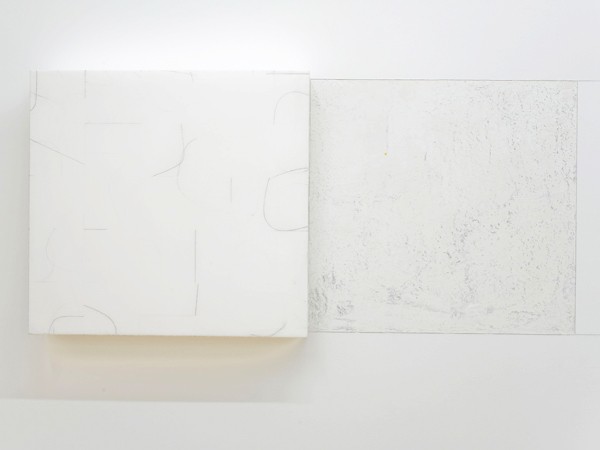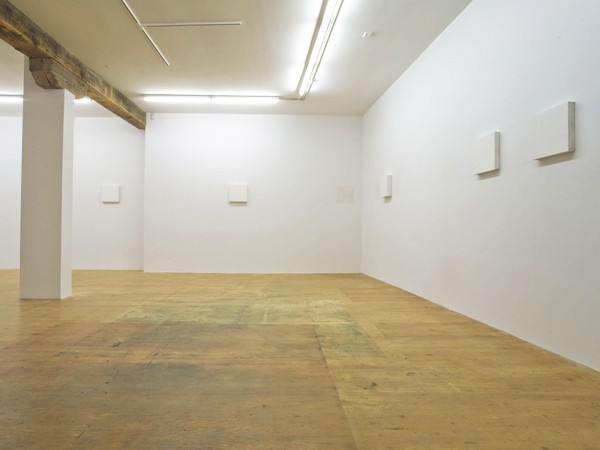For centuries, theories on the nature of painting have sought to explain Man’s experience of color, and yet phenomenological aspects of this question remain unanswered. Cézanne was right when he stated that painting is above all an optical event.1 Painting is a material phenomenon, that has a precise intention, based on a form of visual expression (involving color, line, touch, sign, rhythm, surface, bursts of light, opacity and transparency) whose only goal is to reveal an image, a complete and singular image of the world.
It is precisely this logic of the whole, the force of this absolute constructed through the at once simple and complex relationship between modular painting, architecture and space that is so remarkable in the work of Antonello Curcio. This Italian artist’s residency at LA CHAMBRE BLANCHE culminated in a sober and powerful installation entitled À hauteur du regard.
This site-specific work consisted of inscriptions on the gallery walls, where each mark seemed to be underlined by a sense of its own absence. This was immediately clear in the most striking aspect of the installation work (aside from evidence of the artist’s exploration of the pictorial problematic of the relationship between sign and surface): the absence of color. The entire work reposed on subtle variations in the use of a single color, an absorbent, matt, delicate and yet also intense white. On closer inspection, it was clear that the overlapping, and transposition, of presence and absence was a key feature of the visual composition of the work.
The work featured various volumes and geometric drawings – all similarly sized – along with pencil lines visible through fine layering in the work, as well as traces created with an exacto, which were perfectly integrated into the architectural surfaces. However, all of these features seemed to manifest a sense of absence, linked to an unexplainable void in materiality itself; an incomplete materiality, that did not correspond to any sense of origin so much as to a conjunction of phenomena, including vibration, transparency and the trace of silence, as contemplated in time.
It was only a matter of observing the luminosity of volumes produced by the strange dynamic between a dimly-lit white and a vibrant grey, or the sense of absence in the shadows created by the depth of the paintings protruding from the walls, in order to comprehend the extent to which Curcio’s work opened up a horizon of reflection that was purely phenomenological in nature, beyond all reference points. It was only a matter of looking, in order to comprehend the extent to which, above all, his work examined the potential and limits of plasticity and the medium of painting itself, in a complex and intimate process that was revealed to the viewer with finesse and determination.
Pierre Fédida wrote that, “the only thing that can be said of images is that they are neither true nor false, they simply are, or else they are through what they produce.”2 Antonello Curcio’s work confronted us with precisely this observation. Faced with his work, the viewer felt sheltered from all verbal preoccupations and thematic confusions; sheltered from all obvious forms of seduction and spectacular excitement, the viewer experienced a great and mute sense of satisfaction. A sense of otherness emerged somewhere between the immediacy of our being and our awareness of the deep, slow and limpid breath of life, a breath that explains nothing, that recounts nothing, but which simply is.
As viewers, we felt both astonished and moved; we felt that we had no choice other than to ask ourselves: are images ultimately a form of correspondence that is mute and solitary? Are images a form of reality that can never be entirely comprehended, which exists only by means of repetition and endless difference? Can images be measured in any way other than through the gaze of the other? How may images defend themselves, if not through the emergence of a phenomenological fragility?
In this way, Curcio’s work offered neither an affirmation nor a proposition. Above all, it brought forth the moment of meeting that opens up a space sui generis; a space in which all that is offered us is the ultimate aspiration of becoming that which we are given to be, of being elevated to the height of our own gaze. Art is always a possibility and never an observation, offering inspiration as much for the creator as the public. An art work offers a form of continuity, a circuit of experience that simultaneously and paradoxically cannot exist outside of its own history, that can only be savored by way of a form of subjectivity that enables the perpetual transformation of the senses.
Offered to the other, through a contiguous articulation of the image, presented as both an image and object that visually evokes several layers of reality. Antonio Curcio’s work undoubtedly asks a range of such questions, obliging us to rethink the nature of imagery and its ontological dimension of trace within the overall existence of space. Moreover, Curcio’s work obliges us to rethink space as an element that functions poetically and physically as a form of organic link between two experiences: the human and the artistic. Essentially, this space is a fusion of distinct situations and experiences into a single instant in which there is a superposition, of the point and the whole, the original and the new, the possible and the necessary.
- Cézanne, Paul et John Rewald. 1978, Correspondance. Paris: B. Grasset editions, 346 p.
- Fédida, Pierre. 2009, Le site de l’étranger: La situation psychanalytique. Paris: Presses Universitaires de France editions, p. 213.


